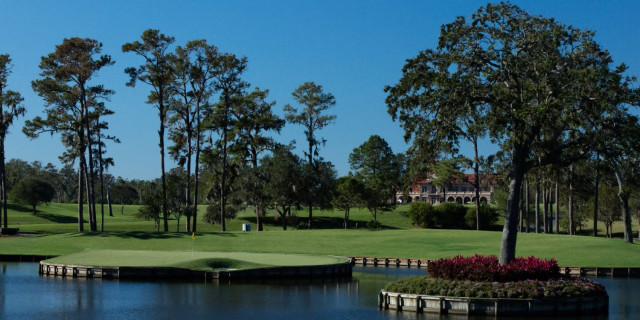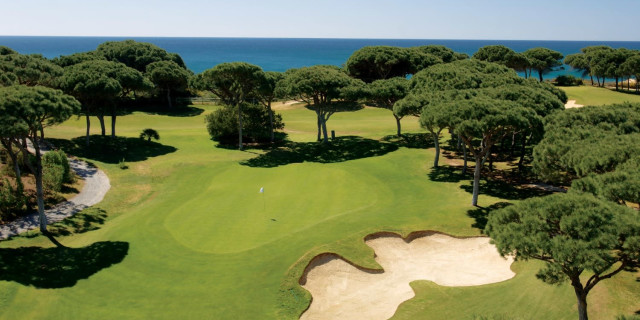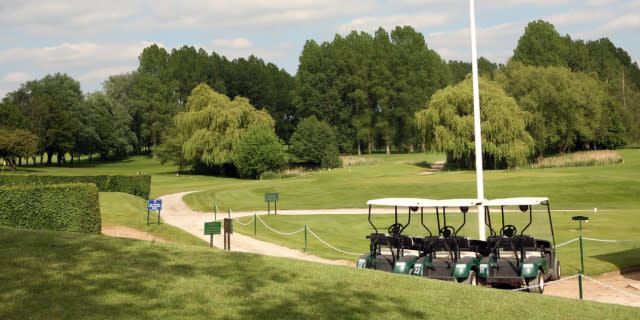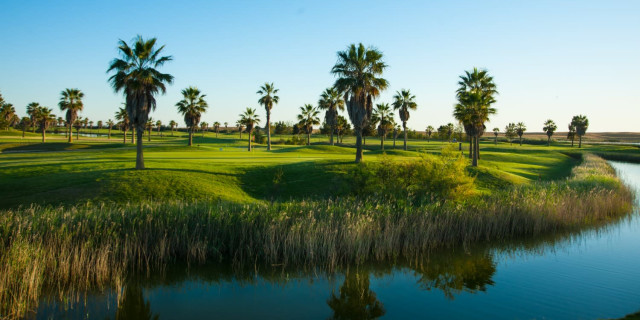The Manor House Stay & Play Review
Review by Golfshake Ambassador Andy Picken
The Manor House Golf Club is a beautiful and classic parkland course set deep in the Cotswold Valleys offering stunning views. The golf course is located adjacent to the archetypal English “chocolate box” village of Castle Combe, Wiltshire.
Only 10 minutes from Junction 17 of the M4, The Manor House is an excellent place to play as the course has been set within some of the most idyllic scenery which can be seen from an English golf course. The course is built on a Cotswold brash which makes it drain freely due to the limestone base.
I can only imagine the excitement when Peter Alliss and Clive Clark were asked to design a course carved through the mature oak and beech trees that line the now beautifully manicured fairways. The elevation changes offered by the terrain, together with the immaculate greens and the River Bybrook meandering through the middle, bring both drama and beauty to the 6,500-yard layout.
This Championship 18-hole course is immersed in the hills and valleys of the Cotswolds, with 365 acres of beautiful, rolling countryside as a distracting backdrop.
I will initially concentrate on the golf experience and then detail the exquisite accommodation and gastronomic offering provided by the Manor House Hotel. This is part of the Exclusive Group of Hotels and I have had the pleasure of sampling both Mannings Heath and the South Lodge Hotel previously so I was genuinely excited at the prospect of a visit to another property in the group.

This is an area of outstanding natural beauty so expect the presence of many tourists in the vicinity of Castle Combe Village. There is a park and ride facility for those who want to enjoy the village and its many walks. This is perhaps the best illustration of the general appeal that this beautiful part of the UK offers.
Driving to the golf course leads down a walled entrance driveway supported by a road that wanders through woods and trees. This opens into an expansive car park. The clubhouse has a modern feel. There is an excellent driving range set out with pyramids of golf balls for expectant players.
I had the opportunity to play the course twice, interspersed with a wonderful evening of excellent food and hospitality. I would advise that if you are a first-time visitor consider using a buggy for your first round. There are some long, steep gradients between tees and greens and not knowing the routing makes these seem longer than they actually are. Once you are orientated it is walkable and many members carry or use trolleys without issue.
Front Nine

The course opens with a hole called Bailey. This is because the green is set on the edge of an ancient Mott and Bailey fortification. The historical significance of this ground led to design restrictions with no bunkers being allowed. This does not lessen the dramatic impact of this first hole particularly when played from the Championship tees over water. Ridges and swales and an elevated green ensures that this hole has a challenging feel.
Moving onto the simply stunning 2nd hole, called Dipper Bridge. It utilises the Bybrook Valley beautifully. This hole has an amazing feel from the elevated tee. The green is well protected by its tiers and subtle undulations. This is a short hole that encourages the use of provisional shots even if the first ones are sitting on the green. It really is that good!
The 3rd called Dunstaville plays from 220 yards off the tips and offers an interesting visual challenge. No water in play, simply a continuously joined snake of a bunker that runs from the nearest tee box to the approach of the green. It wanders with a free form shape that makes it look much bigger than the ground area it actually takes up. This is another clever design feature.
The 5th is a par 4 of 467 yards length. It is called Triangle and is well described as the dog-leg is almost at a 90-degree angle. It is a tight left to right dog-leg, again extensively bunkered, especially at the elbow of the turn. Water comes into play for the majority of the right side of the hole. How much of the corner you can cut without dropping into the swales and hollows alive with grabby, thick grasses. The adjacent fairway is out of bounds to the right so don’t be too tempted to try this as a bail-out either.
Known as Mackenzie, the 7th is a par 5 that requires accurate and strategic play from the tee. Avenues of trees create a channel of flight for the tee ball that needs to be shaped from right to left but also it needs to avoid the pot bunkers that lurk on either side of the fairway. The green is protected from all sides by bunkers and sharp gradients so anyone reaching this green in two will have played quality shots.
Another stunner, the 8th, Stepping Stones is played from an elevated tee that shows exactly what is required as all hazards are easily seen. The green is well protected but most players will still be tempted into a drive that attempts to reach the green.
Finally, the 9th is known as Castle and features a three tiered green and is played directly back towards the clubhouse. It is a thin, narrow green so club selection is important especially when the wind blows.
Back Nine
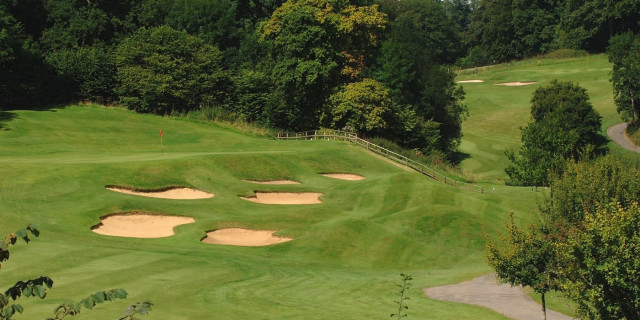
Old Plantation is the 10th, a sweeping par 4 that dog-legs right to left. A narrow ribbon of fairway is provided within elevated swales and hillocks. OOB runs the entire length left to stop anyone wandering into the driving range. Any balls leaked left need to be closely examined before being played as there are some range balls that escape from the range.
Next is School - another excellent short hole. Played downhill, clubbing can be difficult as the wind direction is usually directly into the player. The green is enveloped by established trees that can also affect wind direction and strength. There is a partially concealed public footpath to the left side of the green. This is part of the Macmillan Way that links Abbotsbury Dorset to Boston in Lincolnshire and is a popular walking route.
The 12th is known as Doolittle and is a potential card wrecker. Teeing from an elevated tee to a plateau below. There is a steep valley at the end of the fairway at around 230 yards. Tightly cut fairways encourage overhit shots to gather into the River Bybrook. The next shot is a tight approach over the river to land on a narrow fairway between a lake on the left and the 8th green on the right. With that negotiated you are still left with a shot to an elevated green that is 50ft above your head with trees around the back and left. Anything right will run straight back down to the road below, unless gathered and captured by one of the six lurking bunkers
The 13th, Broadmead Brook is an intriguing hole that I was, and still am, unsure of the best line of attack. At 289 yards from the Championship tees it is not the longest and should be seen as a risk-reward hole. However, the severity of the gradient and the lack of a defined landing area for the primary shot made this an awkward proposition. There are no flat areas past the trees and I found the sloping lies extremely difficult to play with any level of accuracy.
The next holes follow a much more conventional pattern with each being well framed by the established trees
Moving onto the 17th, Burton Brook - considered the signature hole. It plays from 125 to 154 yards from a set of double tees. Visually this is a fabulous short hole. Two greens nestle at the bottom of a steep valley like a pair of rose-tinted spectacles. A stone bridge forms the nose piece and play can alternate between the greens as the staff decide. The green to the left is guarded by bunkers either side. The green to the right is protected by the Brook. This is another hole where our group voluntarily played provisional balls simply because we could.
Finishing at the 18th, called Woodbury, which at 384 yards is not long but visually looks stunning. The tee shot is played towards a large tree that is set in the middle of the fairway. The green is well bunkered and protected to the right by a beautiful water feature involving a cascading waterfall. This is a stunning way to conclude a round whilst watched by fellow golfers using the patio area that overlooks this area.
Final Thoughts
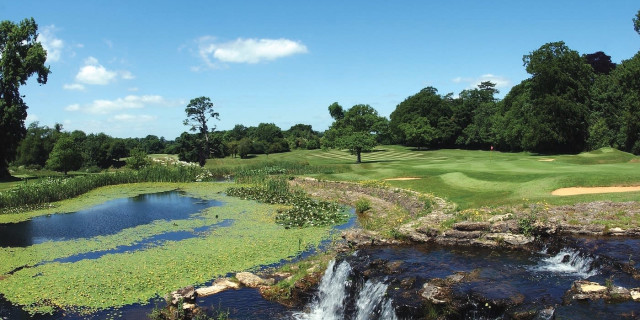
This is a course that provokes memories. I really enjoyed the design and it is clear that Peter Alliss and Clive Clark have entered the head of the average golfer and then messed with it. The excellent drainage offers perfect conditions all year round. The routing is sympathetic to the surroundings and provides stunning views and vistas. There are some excellent holes that will stay with me for a long time. Particularly most of the short holes. Consider the use of a buggy for the first round as you will surely want to play more than once if you have the opportunity.
This is an accessible, all year-round course and there are some great membership deals currently being offered for those who live locally. These offers also provide incentives throughout the Exclusive Group. Check out the Country Membership on the Official Website.
Stay & Play Experience
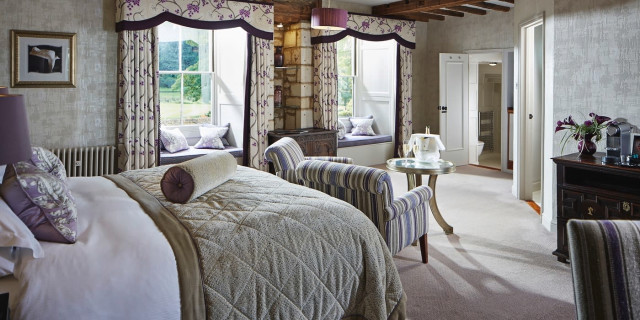
Accommodation for the visiting golfer can be provided by the Waterfall Lodge that is a few paces from the clubhouse and can sleep up to eight golfers. Our place to rest was a suite within the grounds of the 14th Century Manor House Hotel itself.
The grounds have changed use over the years from an orphanage and monastery to the exceptional location that is now provided. 50 individually styled bedrooms and suites are located within the Manor House alone. I was given a suite housed in one of the Mews Cottages leading from the grounds back into the village.
Each of the suites has a unique internal design to the highest standards and the bathroom in my suite was amazing. A bath big enough to house an entire flock of ducks and a double shower with ambient coloured lighting and a bathroom TV.
Proudly displayed in the reception was a page from a 1957 Country Life magazine advertising the auction of the House, its shooting grounds and the local village, pubs and cottages.
The hotel is supported by a Michelin starred restaurant operated by Executive Chef Robert Potter. The same team also run the 12th Century Castle Inn, the village pub, that is yards from the hotel buildings. I have to report that it was simply exceptional.
There are few UK venues that combine this gastronomic quality with an excellent golf course that can be played all year round by the visiting golfer. This was a very special gastronomic golf experience that will live long in the memory. The food, the venue, the course, all provided an experience of the utmost quality. There are times in life when work is not work and this was one of them.

Interesting Connections
My suite for the night was the Doolittle Suite hence the reason for the following research.
“You have never seen anything like it in your life”
A phrase stolen from the film Doctor Dolittle? Are you old enough to now be humming the tune that goes with that phrase? I certainly am.
The golf course was used for shooting the 1967 movie starring Sir Rex Harrison. The entire village of Castle Combe was used as a location. Some interesting issues occurred during the filming. Ducks were introduced to a pond, created for filming purposes, but it was the wrong time of year and the water resistance of the bird’s feathers had been lost, so most of them sank!
The scenes involving the ‘pushmi-pullyu’ two headed creatures were filmed on the golf course. A local group of men attempted to blow up a small dam created by the film production team with the intention of flooding the film set as an environmental protest. One of those involved was Sir Ranulph Fiennes. He later became one of the world’s greatest adventurers being the only human ever to walk to each polar cap and climb Mount Everest. He raised over £6.3 Million pounds for the Marie Curie charity with this climb alone. His later knighthood being awarded for human endeavour and charitable efforts. He was also the first man in history to run seven marathons in seven continents in seven days.
If you have seven minutes to spare please check out his acceptance speech for an Honorary Law Degree at Bristol University. Magnificent!
Ultmately, Castle Combe is a delightful English village that has a special history all of its own. Many scenes for the modern Spielberg classic War Horse were filmed in the village and its surroundings. They simply put soil on the ground to cover the modern road markings and the village instantly was taken back to the First World War era.
The Manor House Golf Club is Highly Recommended on Golfshake!
Related Content: travel review England Courses

